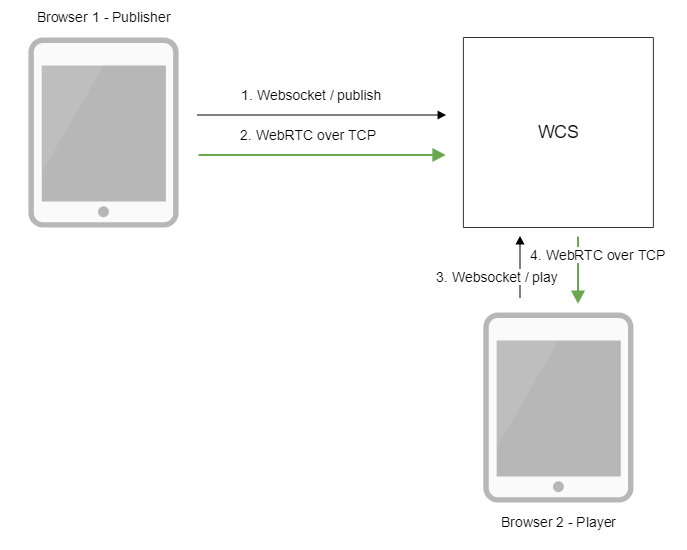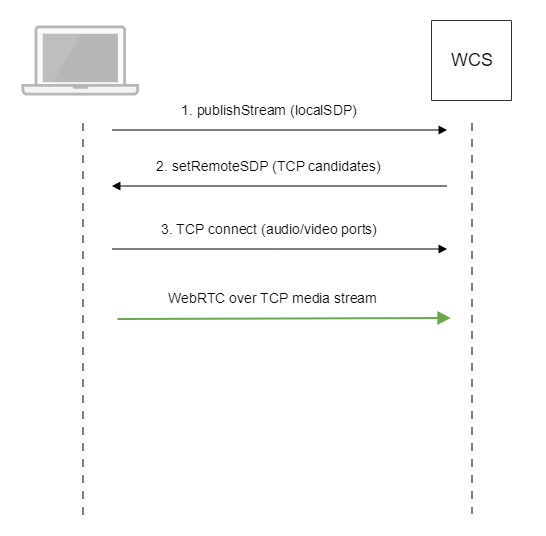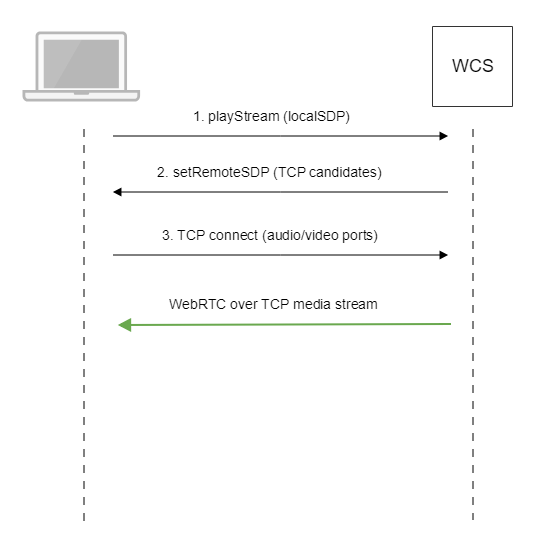Overview
Usually, UDP is used on transport level to transfer WebRTC mediadata. On the one hand, this allows to reduce data transfer latency. On the other hand, high bitrate FullHD and 4K translations quality decreases even on relatively good channels due to packets loss.
If WebRTC translations quality is a must, WCS allows to use TCP on transport level according to RFC 4571 and 6544.
Supported platforms and browsers
Chrome | Firefox | Safari 11 | Edge | |
|---|---|---|---|---|
Windows | + | + | + | |
Mac OS | + | + | + | |
Android | + | + | ||
iOS | - | - | + |
Operation flowchart
The browser connects to the server via the Websocket protocol and sends the publish command.
The browser captures the microphone and the camera and sends a WebRTC stream to the server over TCP.
- The second browser establishes a connection also via Websocket and sends the play command.
- The second browser receives the WebRTC stream over TCP and plays that stream on the page.
Call flow
WebRTC stream publishing over TCP, call flow differs from steam publishing via UDP :
1. Client sends SDP offer to server via Websocket.
2. Client receives SDP with TCP ICE candidates from server:
v=0 o=Flashphoner 0 1545364895231 IN IP4 192.168.1.5 s=Flashphoner/1.0 c=IN IP4 192.168.1.5 t=0 0 m=audio 31038 RTP/SAVPF 111 8 9 c=IN IP4 192.168.1.5 ... a=candidate:1 1 tcp 2130706431 192.168.1.5 31038 typ host tcptype passive a=candidate:1 2 tcp 2130706431 192.168.1.5 31038 typ host tcptype passive a=end-of-candidates ... m=video 31040 RTP/SAVPF 100 127 102 125 96 c=IN IP4 192.168.1.5 ... a=candidate:1 1 tcp 2130706431 192.168.1.5 31040 typ host tcptype passive a=candidate:1 2 tcp 2130706431 192.168.1.5 31040 typ host tcptype passive a=end-of-candidates a=rtcp-mux a=rtcp:31040 IN IP4 192.168.1.5 a=sendonly a=ssrc:564293803 cname:rtp/video/1b951110-04d5-11e9-a8b5-19c6b1a7cdbb
Where 192.168.1.5 is WCS server IP address
3. Client establishes TCP connection to audio and video data ports from SDP and starts to send mediadata.
Similarly, playback call flow goes as follows:
1. Client sends SDP offer to server via Websocket.
2. Client receives SDP with TCP ICE candidates from server.
3. Client establishes TCP connection to audio and video data ports from SDP and starts to receive mediadata.
Configuration
WebRTC over TCP usage is enabled with the following parameter in flashphoner.properties file
ice_tcp_transport=true
Adjusting send and receive buffers
Send and receive buffers sizes are set with the following parameters:
ice_tcp_send_buffer_size=1048576 ice_tcp_receive_buffer_size=1048576
By default, buffers sizes are set to 1 M.
Adjusting TCP queues
TCP queues high and low watermarks are set with the following parameters
ice_tcp_channel_high_water_mark=52428800 ice_tcp_channel_low_water_mark=5242880
By default, TCP queues size is between 5242880 and 52428800 bytes.
Ports used
TCP ports from WebRTC media ports data range are used for WebRTC connection over TCP
media_port_from =31001 media_port_to =32000
WebRTC transport management on client side
Server side settings enable WebRTC over TCP for all the clients by default. If necessary, TCP or UDP transoprt usage can be chosen on client side with WebSDK. To do this, transport to be used should be set in stream options when stream is created for publishing (via UDP for example)
session.createStream({
name: streamName,
display: localVideo,
cacheLocalResources: true,
receiveVideo: false,
receiveAudio: false,
transport: "UDP"
}).on(STREAM_STATUS.PUBLISHING, function (stream) {
...
}).publish();
or playing (via TCP for example)
session.createStream({
name: streamName,
display: remoteVideo,
transport: "TCP"
}).on(STREAM_STATUS.PENDING, function (stream) {
...
}).play();
Quick manual for testing
1. For test we use:
- WCS server
- Two Way Streaming web application to publish and play WebRTC stream in Chrome browser
2. Open Two Way Streaming web application, press Connect, enter stream name test and press Publish. Stream publishing will start.
3. To make sure stream goes to server open chrome://webrtc-internals
4. In Player windows enter stream name test and press Play. Stream playback will start.
5. Playback graphs
6. To make sure TCP connection is established, launch this command on server
netstat -np | grep ESTABLISHED
The following lines will be in command output
# Websocket session tcp 0 0 192.168.1.5:8443 192.168.1.100:60289 ESTABLISHED 7459/java # publishing stream tcp 0 0 192.168.1.5:31030 192.168.1.100:60305 ESTABLISHED 7459/java tcp 0 0 192.168.1.5:31032 192.168.1.100:60307 ESTABLISHED 7459/java # playing stream tcp 0 112 192.168.1.5:31038 192.168.1.100:60515 ESTABLISHED 7459/java tcp 0 817 192.168.1.5:31040 192.168.1.100:60517 ESTABLISHED 7459/java
Where
- 192.168.1.5 is WCS server IP address
- 192.168.1.100 is client IP address
Known issues
1. Some browsers (MS Edge on Windows, Chrome on Ubuntu) do not establish WebRTC connection if additional network interfaces are enabled (VPN)
Symptoms: WebRTC stream publishing and playback do not work over TCP
Solution: disable any additional network interfaces except this one used to access WSC server.
2. WebRTC video cannot be played for all subscribers if one of the subscribers has a channel problems
Symptoms: video cannot be played for all subscribers if one of the subscribers has a channel problems
Solution: enable non-blocking IO with the following parameter
ice_tcp_nio=true
3. WebRTC over TCP requires more RAM comparing with UDP when non-blocking IO is used
Symptoms: with increasing traffic on the server, the RAM iconsumption ncreases sharply, up to the server shutdown
Solution: add more RAM to the server according to the following recommendations
- 64 Gb RAM for 500 Мbps of traffic
- 128 Gb RAM for 1 Gbps of traffic


